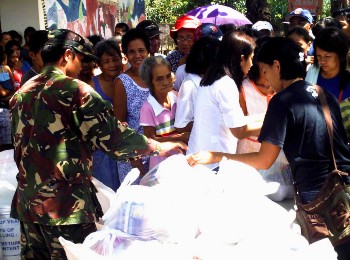About 1 result/s
-
Volume 5, Issue 1, August 2023
The Philippines is highly exposed and vulnerable to tropical cyclones (also known as typhoons), which caused over ₱352 billion worth of losses and damages to agriculture between 2000 and 2021. The study focuses on the impacts of typhoons on banana production in the Philippines. Bananas are a crucial crop for consumption, nutrition and the economy. Mindanao accounts for a majority of the country’s production. The study examines the physical sensitivity of bananas to hazards like typhoons, considering factors such as wind speed, flood-prone areas, and slope, using geographical methods.

-
Volume 5, Issue 1, March 2022
Bringing aid to disaster-stricken communities is complex, especially in the Philippines where destructive typhoons are intensifying due to climate change. This paper illustrates the coordination for humanitarian aid from Philippine government instrumentalities, the military, uniformed personnel, and civilian sectors as well as from, multilateral organizations and non-government organizations, both local and international during state of national calamities like Typhoon Haiyan. Disaster response increases in complexity in conflict zones such as Bangsamoro Autonomous Region of Muslim Mindanao (BARMM), where armed non-state actors have been active for many years. Encapsulated are the perceptions of 30 respondents coming from government agencies involved in disaster risk reduction and management, including the military and uniformed personnel including humanitarian and relief agencies, during both peacetime and conflict. This embodies challenges in civil-military engagement in balancing mandated tasks such as security, maintaining peace and order, preserving sovereignty, and preventing terrorism with adherence to humanitarian principles and frameworks even while striving to deliver basic humanitarian services in the nexus of climate change and conflict.

-
Volume 4, Issue 1, January 2021
The Philippines is one of the countries
highly vulnerable to climate change, and this condition threatens further the meager
agricultural production in the country. However, while the Philippines has
established the institutional foundations linking climate change to agriculture,
through policies and legislation, advances in climate change adaptation have
been slow, especially at the local level. This paper demonstrated that this gap
in policy formulation and actual implementation stems from the lack of institutional
analysis in CCA efforts in the Philippines. The paper concludes that along with
the scientific and technological discussions, institutional conversations
should be among the initial vital steps in CCA planning, and policy and
decision-making. It further advocates that institutional analysis can be the
entry point for designing reforms toward effective CCA implementation.

-
Volume 4, Issue 1, November 2019
The Philippines is a global player in sugar cane production with Negros province, aka “sugarlandia”, accounting for 80% of national production. As changes in climatic conditions have and will continue to directly or indirectly affect sugarcane production, we should understand better how climate change and the El Niño-Southern Oscillation (ENSO) events will impact production targets and future irrigation requirements. This paper demonstrates how a crop model can be used to assess the present and mid-century impacts of ENSO and climate change on sugarcane growth and productivity in Negros Occidental province, Philippines.
-
Volume 3, Issue 1, August 2017
Philippine reefs are mega-diverse but, to date, few ecosystem models have been developed to understand their dynamics and functioning. This study assessed the status of reefs in 12 municipalities of Leyte Gulf, Philippines.
-
Volume 2, Issue 1, November 2016
Recently, corn farmers in Abuan Watershed and Isabela Province are experiencing declining crop yields caused by insufficient amount of rainfall. To increase crop yields and reduce production risks, research on better use of available rainfall and better understanding on effects of climate variability, and soil and field management on crop production is imperative.